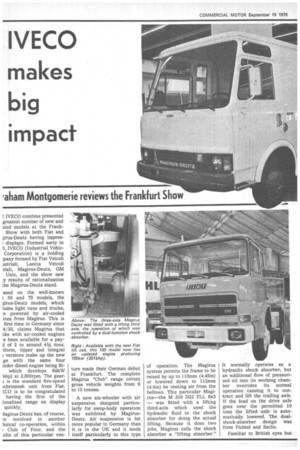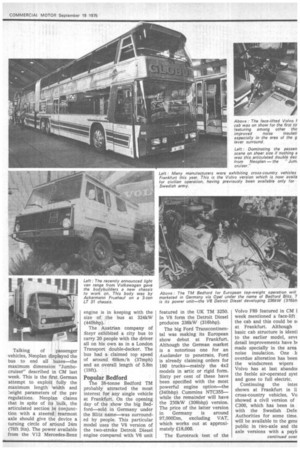IVECO makes big impact
Page 40

Page 41

Page 42

Page 43

Page 44

If you've noticed an error in this article please click here to report it so we can fix it.
.aham Montgomerie reviews the Frankfurt Show
!, IVECO combine presented greatest number of new and ited models at the FrankShow with both Fiat and • lirus-Deutz having impresdisplays. Formed early in 5, IVECO (Industrial VehicCorporation) is a holding ipany formed by Fiat Veicoli astriali, Lancia Veicoli ciali, Magirus-Deutz, OM Unic, and the show saw .y results of rationalisation the Magirus-Deutz stand.
ased on the well-known t 55 and 75 models, the girus-Deutz models, which Ludes light vans and trucks, .e powered by air-cooled ines from Magirus. This is first time in Germany since 4/35, claims Magirus that cics with air-cooled engines e been available for a pay1 of 2 to around 4% tons. tform, tipper and integral versions make up the new ge with the same four inder diesel engine being fit which develops 64kW bhp) at 2,800rpm. The gear is the standard five-speed ichromesh unit from Fiat. CO is to be congratulated having the first of the ionalised range on display quickly.
rlagirus-Deutz has, of course, involved in another hnical co-operation, within Club of Four, and the ults of this particular yen ture made their German debut at Frankfurt. The complete Magirus "Club" range covers gross vehicle weights from 6 to 13 tonnes.
A new six-wheeler with air suspension designed particularly for swop-body operation was exhibited by MagirusDeutz. Air suspension is far more popular in Germany than it is in the UK and it lends itself particularly to this type of operation. The Magirus system permits the frame to be raised by up to 113mm (4.45in) or lowered down to 112mm (4.4in) be venting air from the bellows. This particular Magirus—the M 310 D22 FLL 6x2 — was ' fitted with a lifting third-axle which used the hydraulic fluid in the shock absorber for doing the actual lifting. Because it does two jobs, Magirus calls the shock absorber a "lifting absorber." It normally operates as a hydraulic shock absorber, but an 'additional flow of pressurised oil into its working chamber overrides its normal operation causing it to contract and lift the trailing axle. If the load on the drive axle goes over the permitted 10 tons the lifted axle is automatically lowered. The dualshock-absorber design was from Fichtel and Sachs.
Familiar to British eyes but not as common in Europe was an eight-wheeler — again on the Magirus stand. This differs from the one marketed in the UK as it was fitted with the V10 engine producing 224kW (310bhp) compared with the V8 for Britain. The model on display was in the livery of Esso (Switzerland) and had a tank body by Esterer with a capacity of 24,000 litres (5,280gal).
Not to be outdone by its IVECO partners, Fiat had five new or updated models at Frankfurt. Pride of place went, not surprisingly, to the 170/ 190 range described in the September 5 issue of CM. Two engines are available for this range, the six-cylinder unit at present fitted to the 619, and a V8 of 17 litres (1,037cuin) capacity which produces 246kW (330bhp).
The brand new 170/190 range has brought Fiat into tine with 'the European competition in that a tilt cab is now available, and, at Frankfurt, this facility was shown for the first time on the 110 and 130 medium-range trucks.
The 130 has been updated to become the 130/20 powered by a 150kW (201bhp) in-line six and is available as a truck (designated NA) with four wheelbase options and a tractive unit (NT).
Small cross-country vehicles were very much in evidence at Frankfurt and the Fiat stand was no exception. Again a new range, the 4x4 65, 75, and 90PC models have gvws of between 6 and 10 tonnes and have been designed specifically to maintain mobility in off-road conditions. The 65 and 75 PC models were exhibited with the 65 having a four-cylinder diesel engine of 3.46 litres (211cuin) capacity and the 75 model using larger 5.18-litre (316cuin) six-cylinder unit.
Inter-City coach
Last but not least of the new Fiat models was a small inter-city coach based, both mechanically and structurally, on the 50 NC. Designated the 50 Al, the new model comes with two basic interior trims depending on whether it is used as a coach or a scl bus. The length of the A 6.54m (21ft 5in) and the ti ing coach version on the . stand was 1.9m (6ft 3in) h Being the showplace of German commercial veh industry, the home proch were well to the fore at Fri furt with the whole of one being taken up with the m of MAN and Mercedes-Ben2 Although they are not r keted in the UK, the un floor-engined MANs, based the old Bussing design, very popular in Germany an addition to the "Unterf range was on show. This a 13-tan model powered b M A N five-cylinder di engine coupled to an All matic box. This particular ion is intended for urban • ery work with the optional lanual gearbox being avail for long-distance opera. Obviously MAN is very cious of the fact that the a cost of an automatic unit be justified only in terms le claimed decreased dawnwith the driveline com. ints in a stop-start vehicle. ne of the MAN trademarks e steering-column gearige—looks to be on the out. Several of the trucks 'rankfurt had conventional • changes whether a ZF or uller gearbox was fitted.
says that the floor lever been used to provide the a leverage found necessary wercome the higher shift es required with synchroh boxes, but that it will be available with the 3tant-mesh Fuller design reasons of standardisation, se near vertical instrument ?.] found in MAN trucks given way to a more .ed design, which I found much easier to see and ild eliminate false readings ;ed by the steep angle of an of the earlier layout.
illy and semi-automatic boxes appeared on a numof trucks at Frankfurt and of the MAN vehicles, a 20 FNL, had the Eaton apper" box, which allows driver to forget about the ch apart from starting a rest. The Eaton design still be used as a convenal transmission if the er prefers it.
aviem and MAN have a t marketing agreement as as their production supply ngement over engines and 3. In Germany, the Saviem t range is marketed by N under the MAN marque Le, but this arrangement been changed with the of Four vehicle, which retain the Saviern identifian albeit with the addition :he MAN logo. It will be resting to see the comparasales progress of the two rman" club trucks during next year.
he New Generation range trucks from Daimler-Benz now been extended down he medium-weight category ;isting of 10, 12 and 14iers. The cab is identical to unit found on the heavyghts, and the sleeper cab ;ion will also be available option. Three engine types available, depending on the The 10 and 12-tonners are fitted with naturallyaspirated and turbocharged versions respectively of the in-line six OM 352 while the 14-tonner uses the V6 OM 401. These engines have power outputs of 96, 124 and 141kW respectively (130, 168 and 192bhp). The 14-tonne tractive unit designated the 14245 is fitted with a derated version of the V8 engine found in the 1626 model already sold in the UK. In this form it produces 179kW (240bhp).
On the bus •side MercedesBenz showed a prototype of a small bus based on one of the Dusseldorf-built transporter range. The prototypes has a seating capacity of 11 and is fitted with self-levelling air suspension designed to remain constant under different load conditions. The mechanical details include a 63kW (85bhp) diesel engine coupled to a four-speed automatic transmission. Talking of passenger vehicles, Neoplan displayed the bus to end all buses—the maximum dimension "Jumbocruiser" described in CM last week. This is the first German attempt to exploit fully the maximum length width and height parameters of the psv regulations. Neoplan claims that in spite of its bulk, the articulated section in conjunction with a steered rearmost axle should give •the device a turning circle of around 24m (78ft 9in). The power available from the V12 Mercedes-Benz engine is in keeping with the size of the bus at 324kW (440bhp).
The Austrian company of Steyr exhibited a city bus to carry 20 people with the driver all on his own as in a. London Transport double-decker. The bus had a claimed top speed of around 60km/h (37mph) and an overall length of 5.8m (19ft).
Popular Bedford
The 38-tonne Bedford TM probably attracted the most interest for any single vehicle at Frankfurt. On the opening day of the show the big Bedford—sold in Germany under the Blitz name—was surrounded by people. This particular model uses the V8 version of the two-stroke Detroit Diesel engine compared with V6 unit featured in the UK TM 3250. In V8 form the Detroit Diesel produces 236kW (316bhp).
The big Ford Transcontinental was making its European show debut at Frankfurt. Although the German market is a notorious one for an Auslander to penetrate, Ford is already claiming orders for 180 trucks—mainly the 4x2 models in artic or rigid form. Sixty per cent of these have been specified with the most powerful engine option—the (340bhp) Cummins NTC355— while the remainder will have the 230kW (308bhp) version. The price of the latter version in Germany is around 97,000Dm, excluding VAT, which works out at approximately £18,000.
The Eurotruck test of the Volvo F89 featured in CM 1 week mentioned a face-lift the cab and this could be s( at Frankfurt. Although basic cab structure is identi to the earlier model, sev€ detail improvements have IN made specially in the area noise insulation. One . overdue alteration has been the windscreen wipers Volvo has at last abandot the feeble air-operated syst and gone to full electric.
Continuing the Intel shown at Frankfurt in li cross-country vehicles, Vo showed a civil version of C300, which has been in with the Swedish Defe: Authorities for some time, will be available to the gent public in two-axle and tin axle versions with a payIs [city of up to 2.7 tons. The ne for this range is the ro six-cylinder B30 petrol ne with an output of (125bhp).
le example on the Volvo d was arranged to show articulation and the .oach angles, and very long p stops were fitted.
le Volvo Club of Four ks were very much in evi1..e at Frankfurt and, for the time, prices were quoted. 3.85m (12ft 8in) wheel! F609, for example, gned for a gross weight of tonnes was priced at 00Dm. To put this into pective the price of a typiF88 4x2 artic, already well wn in Britain, is 97,975Dm. current price in sterling an 88 is around £12,500 ?nding on the specification, th means the 8-tonner Id be about £5,000—if it is marketed over here.
he "other" Swedish manuurer was presenting a new ;e of trucks for the first ,—the 81 and 86. The usual nia policy with regard to numbers of adding a digit m the truck has been upd has been followed again, oh means that we now a two Swedish trucks with type number "86."
he new 81 featured at rikfurt—the LB81S 54—was :d with an Allison autornagearbox. Both the new idles incorporate the imved cab• first shown at ssels earlier this year with two-spoke steering wheel improved sound insulation.
was a pity that the numof British vehicles at nkfurt was small when 'pared with the strength of opposition; British Leyland ; a very noticeable absen For the past few years Frankfurt has been the showcase for Europe as far as commercial vehicles go and this year was no exception. I await with interest the next example of rationalisation from 1VECO.
















































































































